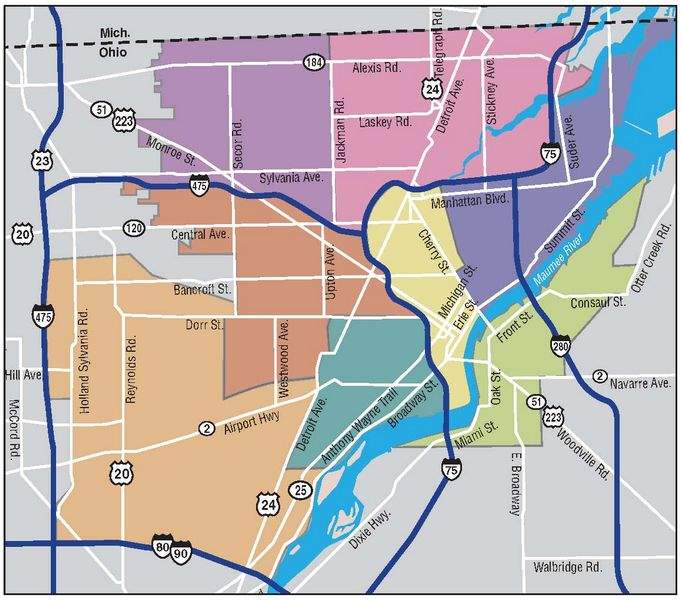
Toledo Police Department to redraw boundaries of districts
2/23/2009
The city's police map could be changed from seven sectors to eight, as shown here. There are other proposals on the table as well, including one that divides the city into four sectors and two others that call for six sectors.
In an effort to deal with shrinking ranks, the Toledo Police Department s district boundaries will be redrawn for the first time in more than a decade to help balance the work load among officers and increase efficiency, police Chief Mike Navarre said.
The goal of the proposed plans, to be finalized by June 30, is to re-establish sectors to reflect the department s current manpower.
The boundary lines will be redrawn based on self-initiated police activity any police work that officers do but are not dispatched to and the volume of calls for service, which has changed considerably since the city was redistricted in 1995, the chief said.
The system that is in place today is not consistent with our current manpower levels, Chief Navarre said.
It was designed to accommodate a growing police department, he said. In reality, we don t have that here.
The city currently has 634 sworn officers. That number is expected to drop to about 600 by the end of the year because of retirements.

The city's police map could be changed from seven sectors to eight, as shown here. There are other proposals on the table as well, including one that divides the city into four sectors and two others that call for six sectors.
With a limited number of resources, which we certainly have right now, it s important we maximize efficiency, the chief said.
The department s current map divides the city into seven sectors with 50 beats, which are areas within each sector that officers are assigned to patrol.
The city s changing demographics over the last 14 years created an imbalance in work between the sectors and officers assigned to them.
As a result, officers in less busy sectors are often dispatched to help crews in busier sectors.
The goal is to even the work load as reasonably as we possibly can, Chief Navarre said. We don t want one beat getting 16 to 20 calls a day and another beat getting three or four calls a day.
Toledo police Lt. Mike Troendle conducted a five-month redistricting study in which he reviewed calls for service and self-initiated police activity during an 18-month period from January, 2007, to June, 2008.
From that information, Lieutenant Troendle created four proposed plans for new sector boundaries that more evenly balance the work.
One plan divides the city into eight sectors, another divides it into four, and two plans require six sectors.
The sectors are not equal geographically, but reflect a more balanced work load, Lieutenant Troendle said.
The eight-sector plan would require 25 officers assigned to 16 beats.
The largest beat would have 7.36 percent of the calls and the smallest would have 4.48 percent. That equates to a difference of about five incidents per shift per day, Lieutenant Troendle said.
The lieutenant recommended adoption of the eight-sector design because it requires the fewest personnel and the small, symmetrical design of the sectors should prove to be the most efficient layout.
Dividing the city into four sectors would require 28 officers and 18 beats. Similar to the eight- sector approach, it would have a difference of five incidents per shift per day between the largest and smallest beats.
Both six-sector plans require 26 officers assigned to 17 beats and provide the smallest variation in incidents between beats. The largest beat would have 7.13 percent of the calls and the smallest would have 4.35 percent.
The difference between the two six-sector plans is how the two radio channels are divided. One uses Jackman Road as a divider and the other uses I-475.
Chief Navarre will determine which plan goes into effect.
Dan Wagner, president of the Toledo Police Patrolman s Association, said the union also is in favor of the eight-sector plan because it is geographically similar to the current map.
I think our guys would be at least somewhat more accepting of that plan than the other ones that are out there, Mr. Wagner said.
He said the current system often requires officers to be pulled from one sector to another to help with incidents, which has led to lengthened response times.
It s really increasing response times, Mr. Wagner said. When those busier sectors get more calls, they re pulling officers from less-busy sectors. It leaves that huge portion unprotected while those officers are helping other sectors.
Chief Navarre said that by balancing the work load among beats, the need for officers to leapfrog from one sector to another should decrease.
By striving to keep units within their sectors and within their beats is going to reduce travel time and is going to result in [quicker] response times, the chief said.
Additionally, maintaining a strong beat system allows officers to become familiar with the geographical layout of the area and with problem spots in a particular neighborhood.
It s impossible to have knowledge of 88 square miles of the city, but it is more practical to have knowledge of an area that is maybe 10 square miles, Chief Navarre said. Knowledge is really what drives the efficiency of a police department.
Contact Laren Weber at:lweber@theblade.com or 419-724-6050.